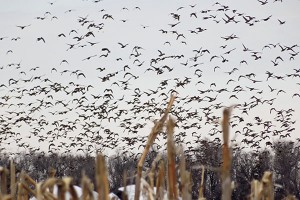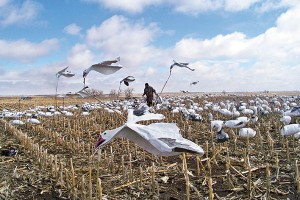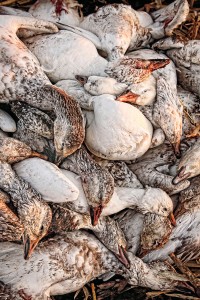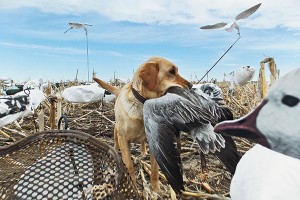December 11, 2013
By Alan Liere
 Flat on my back, peering straight up through the face netting of a ground blind, thousands of snows and blues flew in broken Vs, looking like the Etch-a-Sketch renderings of a child.
Flat on my back, peering straight up through the face netting of a ground blind, thousands of snows and blues flew in broken Vs, looking like the Etch-a-Sketch renderings of a child.
The birds came from all directions, some flying hard and high in formation with an apparent destination, others circling lower, randomly hopeful, and still more spiraling down into fields I couldn't see. I have hunted Canada in the fall and other spring migrations, so I have seen my share of snow geese. But never in the numbers that stretched the horizon during this South Dakota hunt.
I hadn't even planned to be there. When Big Gun Outfitters owner, guide and callmaker Bill Saunders called three days before, I was organizing my tackle box for a go at ice-out mackinaw fishing north of Spokane, Wash. Saunders does most of his guiding for honkers out of Kennewick, Wash., but has hit SoDak the last six years for the reverse migration.
"I've had a cancellation," Bill told me. "You might want to get over here. The snows are stacked up near Mitchell in numbers I've never seen before. They can't go any further north because there's snow and frozen water, and they just keep piling in from the south. We're on the X, and the X is 50 miles wide."
Advertisement
He went on to tell me he thought he had found the mother lode the day before with a field that held some 10,000 birds. Then, he located another field with twice as many. That was good enough for me. I was in Mitchell two days later with friend, Jerry Hawkins.
Winter had returned to Mitchell (22 degrees was the high for the trip), and despite a face mask, gloves, boots and a layout, the bitter north wind made me appreciate chemical heat packs.
Bring the Long Johns
Advertisement
I called Bill and he said we would spend our first and third day with his guide, Mike Callani, and the middle day with him. It was dark, 14 degrees and blowing hard the next morning when we met the crew and headed through Alexandria, before Mike pulled over next to a big machine shed.
 "We're home," he said. "Walk down the road about 200 yards and hang a right into the corn stubble when you see the four-wheel tracks. When you run into about 1,200 white windsocks, you'll know you're in the right spot. I'll take the four-wheeler with the batteries for the Vortex and the electronic calls and meet you there."
"We're home," he said. "Walk down the road about 200 yards and hang a right into the corn stubble when you see the four-wheel tracks. When you run into about 1,200 white windsocks, you'll know you're in the right spot. I'll take the four-wheeler with the batteries for the Vortex and the electronic calls and meet you there."
He pulled his hood over his head and cinched the drawstring. "Lord, that's a bitter wind," he said. Then he smiled. "Yesterday it was really cold, though. My guys cut their hunt short so they could get back to Cabela's before it closed. I think they bought about $1,000 worth of insulated underwear."
Dawn was breaking and there was already a traffic jam of geese above us when we settled into our layouts. New birds were piling in from Missouri and Nebraska, others had already been north, found nothing but snow and ice, and returned to feed. It was a smattering of snow geese, blue geese, specklebellies and honkers. And ducks! Oh, the ducks!
Huge flocks of redheads and bluebills strafed the decoys — the first time I had ever seen divers in a corn field. Even as Mike hooked up the speakers and made adjustments to the spread, flocks of mallards and mature pintails tried to land on the spinning vortex machine. It was easy to see why they wanted our field — there was plenty of unharvested corn.
"Something must have gone wacky with the combine," Mike said. "There shouldn't be this much waste. The sad thing is, though, the field was muddy a few days ago. Now with this cold, the cobs are frozen solid to the ground and the birds have a hard time prying it loose."
"With all these geese and all this food, you'd expect a slam-dunk," Mike continued, "but the first snows to arrive are the adults, and they've been to this rodeo before — they're tough to fool." Mike said he figured the white birds we were seeing had been hunted going on seven months.
"Most first-time spring migration hunters expect to have tornadoes of birds landing on them," Mike said. "But we're getting mostly singles and pairs — juveniles that have flown in with the adults." He said that in the week he had been hunting, only once had he landed a big flock. On that morning, two hunters with extended magazines (legal in the spring) had killed 44 geese on the rise.
I asked him if he thought the liberal spring season was making a difference in the booming snow goose population destroying the tundra. Mike shook his head. "There might be as many as 15 million snow geese up there," he said. We're killing 90 percent juveniles — non-breeders. No, I don't think we're having much affect."
Subliminal Message
 Mike's 1,200 snow goose windsocks and shells formed a mass visible for miles. He had erected several flying decoys on long poles and set up two Vortex machines. Each pushed only two flying decoys, but the way they overlapped as they passed in a circle made it look like more.
Mike's 1,200 snow goose windsocks and shells formed a mass visible for miles. He had erected several flying decoys on long poles and set up two Vortex machines. Each pushed only two flying decoys, but the way they overlapped as they passed in a circle made it look like more.
It seemed there were wires and speaker boxes for the electronic calls all over the field, and indeed, when we first began hunting, we were warned to "pick up your feet." One speaker was pretty close to my head, and after several hours, I thought I could hear patterns in the electronic calls that sounded like human voices.
I would have sworn someone was repeating the phrase: "We have to get going quick, we have to get going quick." I wondered if after a few more days I would be talking back to the speaker.
The shooting, as Mike had predicted, was tough. It was confounding to have the sky packed with birds that appeared not the least interested in our set or the fact Jerry and I had just driven 1,300 miles to hunt them, but I would have driven 10 times that distance just for the show. Now and then, a small flock would break off and drop closer for a look, and sometimes one or two birds would come in.
We didn't have a chance at a flock all day, but we shot well at singles and pairs and scratched down 14, which included a three-hour break for lunch. We actually called it a little prematurely due to frozen toes and fingers. With the wind chill, the temperature was on the minus side of zero.
A third of our birds were blue geese in a variety of color phases. Jerry and I each shot a magnificent adult specimen with a cotton top and mostly white breast that we saved for the taxidermist. My Lab, Jill, quickly reacquainted herself with the process of lying beside me in the blind, her nose poking out the end. I can't say she saved us any birds or made any spectacular retrieves, but she did increase the temperature in the blind. She also gave me someone to blame when the bean burrito from breakfast began causing some intestinal rumblings.
Wait'em Out
The next day, Jerry and I hunted with Bill. We didn't meet at the truck-stop until 11 a.m., and I must say the extra sleep was welcomed. Bill reasoned most of the birds at first light were more interested in getting north than socializing, and we might as well wait until they did their futile reconnaissance and headed back. We drove to a different harvested corn field, but this one didn't have a single kernel of feed.
"The trick," Bill told us, "is to set up between big wads of geese rather than in the field they're using. You're a lot better off in the middle of a triangle. They see white and they come down for a better look."
 Bill's call for a late start played out well that day. We saw no more geese than the day before, but had a lot more looks. Singles and doubles and an occasional small flock filtered into the field and when we pulled the plug at 5:30, almost 50 snows and blues were on the ground.
Bill's call for a late start played out well that day. We saw no more geese than the day before, but had a lot more looks. Singles and doubles and an occasional small flock filtered into the field and when we pulled the plug at 5:30, almost 50 snows and blues were on the ground.
Jerry's sore back had kept him from rising quickly from the blind when Bill called the shot, and I have a tendency to shoot fast, so the next morning, hunting with Mike, Jerry discovered Bill had sent along a spring-loaded catapult chair. This made him a lot quicker on the draw, and it seemed the majority of the 15 geese we took were double-tapped.
Once again, the duck show was spectacular, and I would become almost giddy at the sight of specklebellies settling around me. Mike had a knack for reading the birds, and identified an incoming goose as a blue when I was certain it was a young speck.
Our last day in Mitchell, Jerry and I ate a celebratory steak at the local Perkins. Next to us were a group of guides from Michigan. "You guys do any good today?" Jerry asked.
"Not worth a damn," one of them answered. "Been here three days and have only shot three snows. They're tough."
Jerry and I sympathized, smiled and went back to our steaks. Evidently, even when the X is 50 miles wide, no snow goose hunt is a sure thing.

